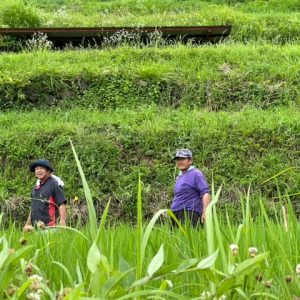Rice walking in Japan
A multitude of OECD reports have proven that Japan’s agriculture sector, and in particular its rice production, is economically inefficient. But there is more to life than economic efficiency.
Rice is an irreplaceable part of Japanese culture, linking myths, deities, and the Japanese people.
You can observe its importance within Japanese families. From offerings of rice to the ancestral alcove and graves, its ubiquitous presence in local and regional festivals, as well as personal milestones, weddings, and celebratory occasions.
During the Japanese New Year’s feast, a spiced sake is drunk to ward off evil spirits and to bring health and good fortune to the family. This is just one of many customs related to rice within Shintoism – Japan’s polytheistic indigenous religion.
Rice cultivation has also famously been depicted in Ukiyo-e woodblock prints, by master artists such as Katsushika Hokusai and Utagawa Hiroshige. Agrarian landscapes of rice fields are a common motif, symbolizing the Japanese identity centered around rice.
It is in this spirit that a non-profit organisation is leading the development of the Inagura’s Rice Terraces in Ueda, a city located in the Nagano Prefecture of Japan.
These traditional rice terraces are spread across the mountain slopes. Built more than 1,300 years ago by industrious people and still in service, they are part of a wonderful scene selected as one of Japan’s 100 best rice terraces.
The rice terraces are owned by a group of people, whose IDs can be seen, attached to a board in one of the photos. The rice fields are worked by retired volunteers, who welcomed my visit.
They are fully aware that the efforts are inefficient. But they insisted that they are committed to organic traditional farming and maintaining Japan’s important tradition of rice farming.





